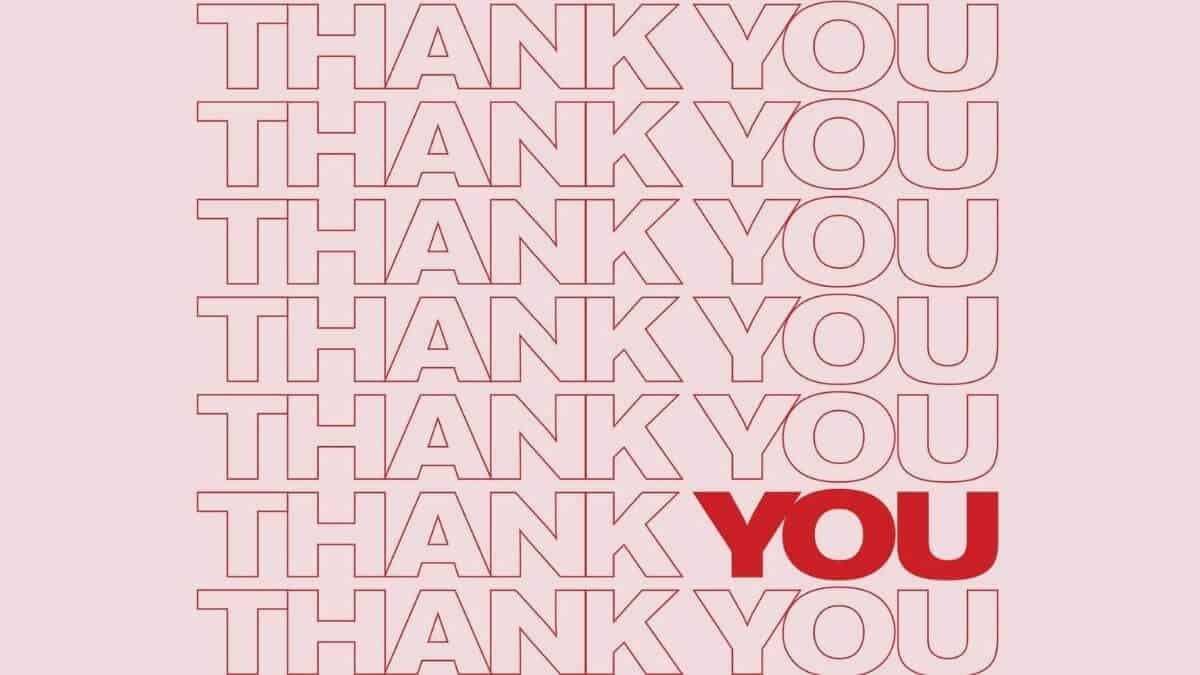Gracias is one of those words that we may use all day long since it allows us to thank people and to be polite. If you’re learning Spanish, you may have noticed that, in order to thank, speakers also use other expressions. This is because gracias is just one way to say thank you in Spanish.
If you want to add more useful phrases to your vocabulary, in this list, you’ll find 12 different and popular ways to say thank you in Spanish. All of these phrases are very common among Spanish speakers. But make sure to read the descriptions carefully since some of these expressions may imply a deeper feeling of gratitude or have a different degree of formality.
By the end of this, you will be able to say thank you in Spanish in 12 different ways.
1. Te lo agradezco / Se lo agradezco – I appreciate it
Both te lo agradezco or se lo agradezco are quite formal ways to say thank you in Spanish. These expressions can be translated as ‘I appreciate it’ and they’re only applied in very formal situations. ‘Te lo agradezco’ addresses ‘tú-you’ while ‘se lo agradezco’ to ‘usted-you’.
Disculpa, ¿me puedes ayudar a llegar al hospital? ¡Te lo agradezco!
Excuse me, can you help me get to the hospital? I appreciate it
| Spanish | English |
| Persona: Señorita, tome, se le cayó su cartera. | Person: Miss, here, you dropped your wallet. |
| Tú: ¡Ay! ¡Se lo agradezco mucho! No me había dado cuenta. | You: Oh my God, I appreciate it very much! I didn’t notice! |
‘Te lo agradezco’ and ‘se lo agradezco’ may have the following variations.
- Te lo agradezco – Te agradezco
- Se lo agradezco – Le agradezco
The difference between these phrases is that the te lo agradezco/se lo agradezco the thing that you’re thanking for is clear (it’s actually being replaced by lo) while with the other options you will need to be more specific.
Katia, en serio te agradezco mucho que me ayudes con mi tarea.
Katia, I really appreciate that you help me with my homework.
Take Note: All of these expressions work with indirect pronouns that you can change to match the person being thanked. Additionally, they include the verb agradecer (to thank) which you can conjugate in any tense.
Vilma le agradeció a Judith por su ayuda.
Vilma thanked Judith for her help.
2.Mil gracias – Thanks a bunch / Thanks a lot
In Spanish, mil gracias is another way to say thank you. This expression can be translated either as ‘thanks a lot’ or ‘thanks a bunch’. ‘Mil gracias’ expresses a lot of gratitude for the help or favor we received. This expression can be used in both formal and informal situations as long as you know that you’re expressing a deep feeling of gratitude.
Additionally, notice that this phrase is always used directly with the person that you’re thanking.
Mil gracias a todos por sus felicitaciones
Thanks a lot, guys, for your wishes
Ay, Jessi, mil gracias por ayudarme con mi tarea
Jessi, thanks a lot for helping me with my homework
Chicos, sólo les quiero decir mil gracias por hacer este año increíble
Guys, I just want to say thanks a bunch for making this year amazing
Nowadays, young people may also use the variation: gracias mil. This expression is more informal than ‘mil gracias’ and it can be a mocking or playful phrase. As a result, you can use it among your friends.
¡Qué rica estuvo la cena! Gracias mil, Ricardo
The dinner was delicious! Thanks a lot, Ricardo
Take Note: Notice that if we don’t have a specific name, we use the preposition a to introduce the person we’re saying thanks to. On the other hand, we use por to introduce the thing or activity that we’re grateful for.
3. Muchas gracias – Thank you very much / Thanks a lot
Muchas gracias is the direct translation of ‘thank you very much’ or ‘thanks a lot’. Therefore, this is one of the most common ways to say ‘thank you’ in Spanish. ‘Muchas gracias’ can be used both in formal and informal contexts.
¡Qué bonita blusa! Muchas gracias, má.
What a beautiful blouse! Thanks a lot, mom.
¡Muchas gracias por ayudarnos con la comida!
Thank you very much for helping us with the food!
James, ya recibí tu regalo, ¡muchas gracias! ¡Está muy lindo!
James, I already received your gift, thank you very much! It’s very pretty!
As you may know, you can intensify this expression by changing muchas to muchísimas.
¡Amigo, muchísimas gracias por venir!
Thank you very much for coming, buddy!

4. ¡Qué amable! – How sweet! / How nice!
Qué amable is another phrase that you can use to say thank you in Spanish. It means ‘how sweet’ or ‘how nice’. This expression is very polite and Spanish speakers use it to thank people for an unexpected favor or when they go beyond what you expected. Since it’s a little bit formal, Spanish speakers may not use ‘¡qué amable!’ to thank their friends and family.
| Spanish | English |
| Tú: ¿Quiere que le ayude con sus bolsas, señora? | You: Do you want me to help you with your bags, Ms.? |
| Señora: Sí, por favor, ¡qué amable! | Lady: Yes, please, how sweet! |
| Spanish | English |
| Mesero: Aquí tiene un postre cortesía de la casa. | Waiter: Here is a dessert courtesy of the house. |
| Cliente: ¡Ay, qué amable! ¿Te puedo pedir otra bebida? | Client: Oh, how nice! Can I order another drink, please? |
Take Note: ‘¡Qué amable!’ can be used both by men and women. Notice that unlike other expressions, this phrase is used to respond immediately to someone’s action.
5. Chido – Thanks
In Mexico, people use the word chido as a way to say thank you in a very casual way. Unlike other expressions from this list, this word can only be used in Mexico. On top of that, ‘chido’ is a slang word and it’s mainly used with this meaning by young people and men. In this context, ‘chido’ can be translated as ‘thanks’.
Chido, compa, mañana te pago.
Thanks, buddy, I’ll pay you tomorrow.
Chido por ayudarme a estudiar Nick, te debo una.
Thanks for helping me study Nick, I owe you one.
Entonces, ¿tendrías más tallas la semana que viene? Bueno, chido.
So, you will have more sizes next week? Okay, thanks.
Take Note: Chido is a very rich word in Mexican slang Spanish, so don’t be surprised if you hear this word in other contexts. Additionally, this word can only be applied in informal contexts.
Related Resource: What Does Chido Mean in Mexican Spanish?
6. Te doy las gracias – I thank you / Thank you
Along with ‘te lo agradezco’, te doy las gracias is one of the most formal expressions from this list. ‘Te doy las gracias’ means either ‘I thank you’ or simply ‘thank you’. This way to say thank you is only applied in formal contexts and you may need to introduce the thing that you’re grateful for.
In order to use this phrase, you need to follow this structure. Notice that:
- Te doy las gracias is conjugated for tú, but you can make some adjustments.
- The subject is the person saying thank you.
- The indirect pronoun points to the person being thanked.
[Subject] + [Indirect pronoun] + [dar gracias conjugated] + por + [complement]
Te doy las gracias por tu ayuda.
I thank you for your help.
Mi hermana quiere darte las gracias por la blusa que le prestaste.
My sister wants to thank you for the blouse that you lent her.
Mamá, papá, les doy las gracias por todo lo que han hecho por mí.
Mom, dad, thank you for all the things that you have done for me.
Take Note: Notice that the position of the indirect pronoun varies in the previous examples. This is due to the sentence conjugation. Make sure you understand how to place these pronouns correctly.
7. Agradecido / Muy agradecido – Very grateful
Agradecido or muy agradecido mean ‘grateful’ or ‘very grateful’. This adjective is becoming quite popular on social media posts, but it can be a little bit cheesy. When using these words in social media you need to make sure to add the thing or person that you’re grateful for:
Agradecido por el apoyo que he recibido.
(I’m) Grateful for all the support that I’ve received.
¡Qué buen fin de semana! Agradecida con todos mis amigos y familiares.
What an amazing weekend! (I’m) Grateful for all my friends and family.
In speaking Spanish, ‘agradecido’ and ‘muy agradecido’ work with the verbs sentirse and estar. In this situation, these expressions are very formal and polite. As a result, they’re mainly used on special occasions.
Estoy agradecido por mi trabajo y mi familia.
I’m grateful for my work and my family.
Lauren y yo nos sentimos agradecidos por todo lo que han hecho por nosotros.
Lauren and I feel grateful for all the things you have done for us.
Take Note: When using this word or expression in social media posts, people remove ‘estar’ and ‘sentirse’ to make this adjective less formal, but also as a way to keep their post short.

8. Gracias de todos modos – Thanks anyway
Gracias de todos modos is a Spanish expression that we use to say thank you when people tried to help us, but for some reason, they couldn’t do it. Therefore, ‘gracias de todos modos’ is translated as ‘thanks anyway’. You can also use its variation ‘gracias de todas formas’. These expressions can be applied in both informal and formal contexts.
Buscaba maletas más grandes, pero gracias de todas formas.
I was looking for bigger suitcases, but thanks anyway.
| Spanish | English |
| Tú: No encontré el libro que necesitas, Yahir. | You: I didn’t find the book you need, Yahir. |
| Tu amigo: Bueno, gracias de todos modos. | Your friend: Okay, thanks anyway. |
9. Un millón de gracias – Thank you very much / Thanks a million
Un millón de gracias is another formal and polite way to express a lot of gratitude. This expression can be translated as ‘thank you very much’, ‘a million thanks’ or ‘thanks a million’. You can use ‘un millón de gracias’ in both formal and casual contexts. But since this expression is leaning more towards the formal side, Spanish speakers may not use it among their friends or family (unless it’s a special occasion).
A los maestros y los alumnos, un millón de gracias por su esfuerzo.
To the teachers and students, thank you very much for your effort.
Un millón de gracias a las personas que nos ayudaron en este proyecto.
Thank you very much to the people that helped us on this project.
Take Note: Un millón de gracias is very similar to mil gracias. The only difference between these expressions is their degree of formality. If you don’t want to sound too intense, you may want to use ‘mil gracias’ instead.
10. Gracias de todo corazón – Thank you from the bottom of my heart
Just like its English version, gracias de todo corazón is a Spanish phrase that expresses a sincere and deep feeling of gratitude. This phrase can be used in all contexts as long as you’re aware that you’re expressing deep feelings.
Gracias de todo corazón por sus buenos deseos.
Thank you from the bottom of my heart for your good wishes.
Miriam, gracias de todo corazón, me ayudaste muchísimo, amiga.
Miriam, thank you from the bottom of my heart, you helped me a lot, my friend.
Using this expression doesn’t depend on the formality of a situation, but rather about the gratitude that you feel. So make sure you use it correctly.
11. Se agradece – It’s appreciated it / Appreciated
Se agradece is an impersonal expression to say thank you. This doesn’t mean that this phrase is cold or rude: it means that you’re not addressing a specific person. ‘Se agradece’ is used when talking to a general audience and we’re saying thank you in advance for their help.
Se agradecen donadores de sangre.
Blood donors appreciated.
Chicos, se agradece su ayuda para adoptar dos gatitos.
Guys, your help in adopting two kitties is appreciated it.
Se agradecen todos los juguetes usados que puedan regalar.
All used toys that you can donate are appreciated.
Take Note: As an impersonal expression, se agradece doesn’t have a subject. Therefore, it’s conjugation will depend on the object of the sentence (toys, blood donors, help, etc.).
Related Resource: How to Use ‘Se’ in Spanish
12. Gracias – Thanks / Thank you
As you may know, gracias is the direct translation of ‘thanks’ or ‘thank you’. So this is the most common way to say thank you in Spanish daily conversations. ‘Gracias’ can be used in both formal and informal contexts.
¡Gracias por venir, bienvenidos!
Thank you for coming, welcome!
¡Nos la pasamos muy bien, gracias a todos!
We had a great time, thank you all!
Amor, gracias por las flores tan bonitas que me enviaste.
Sweetie, thanks for the beautiful flowers that you sent me.
Take Note: Like other phrases, gracias works with por to introduce the thing that you’re grateful for. But if you want to focus on the person, you will need to use the preposition a.
Wrapping Up
Saying thank you is a common action in any language. For that reason, we compiled 12 expressions and words that you can use to say thank you in Spanish. Remember that the key to using these expressions is knowing their formality as well as their degree of gratitude.
Now, you’re ready to start including these expressions in your daily Spanish conversations.
Related Resource: Different Ways to Say You’re Welcome in Spanish



